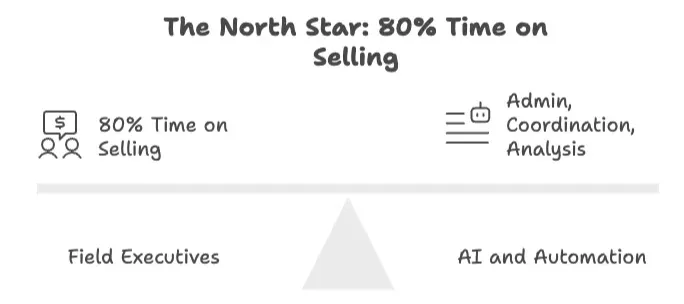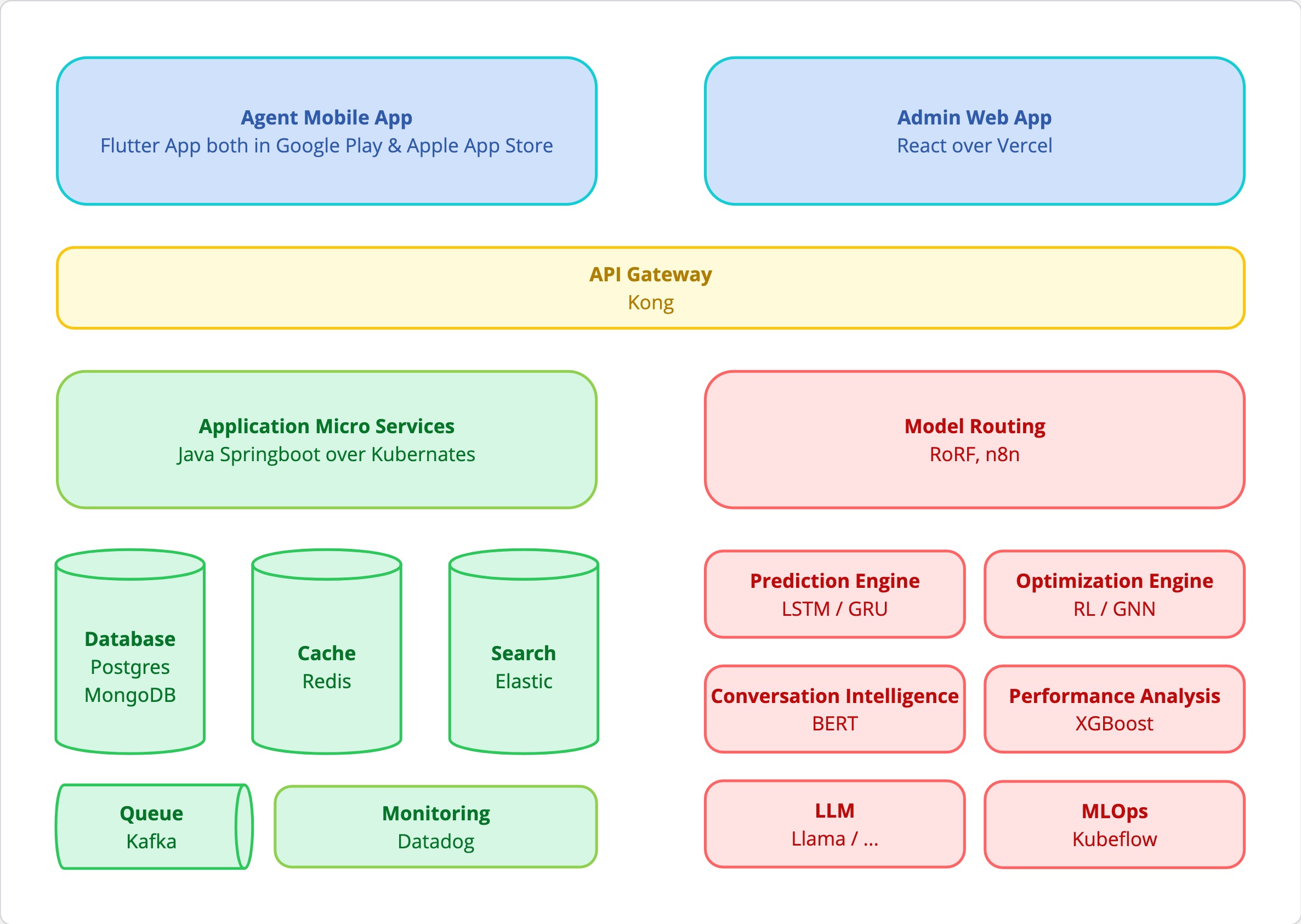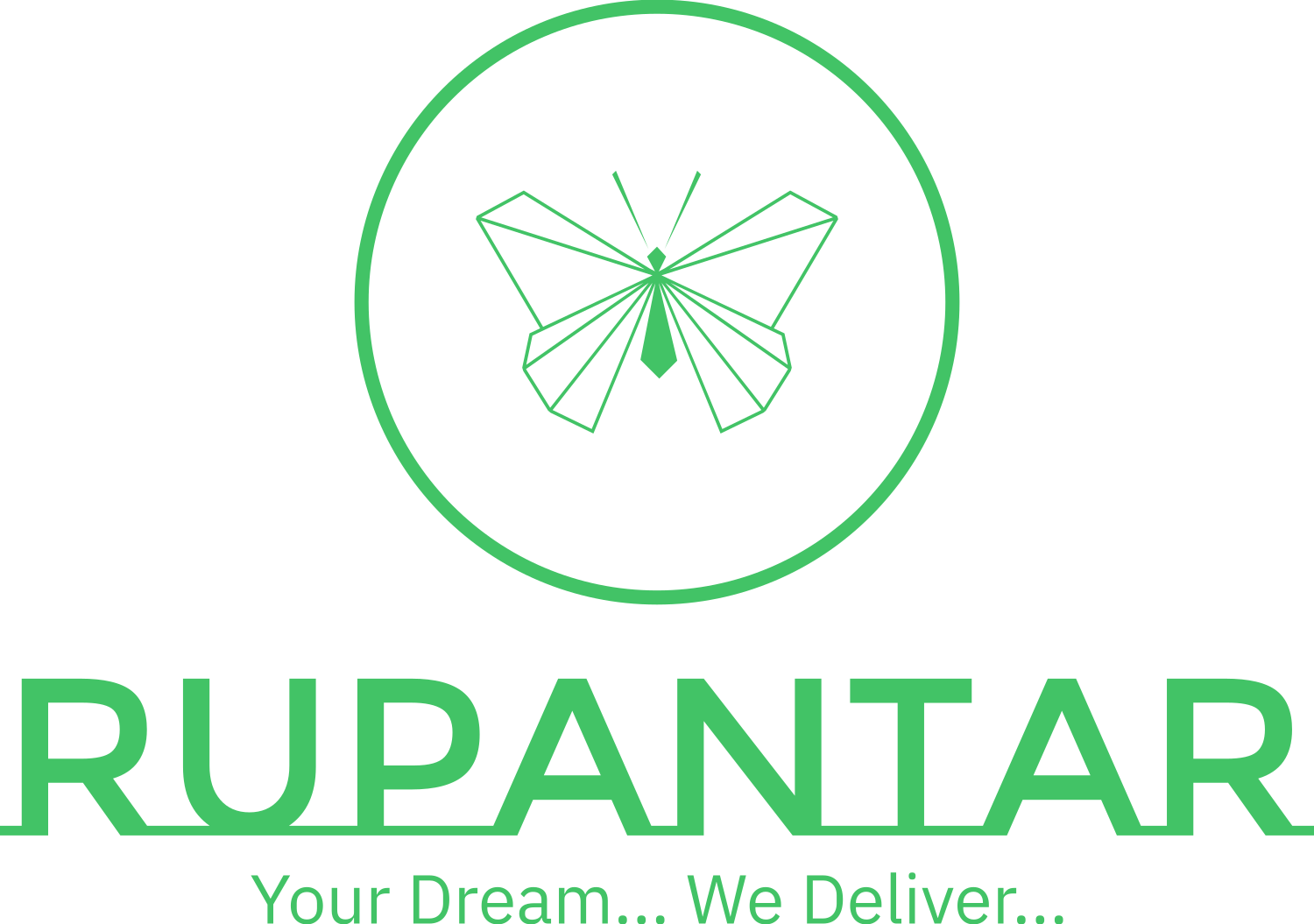
🎯 The Field Sales Performance Challenge
In B2B sales, field executives are the core drivers of revenue. Yet, across industries—whether it's pharmaceuticals, FMCG, consumer electronics, or industrial equipment—we have noticed a strikingly consistent problem: field sales teams are buried under layers of operational complexity instead of doing what they excel at—selling and building trust.
💡 Key Insight
Field sales executives spend only 35% of their time on selling activities. The remaining 65% is absorbed by administrative tasks, data entry, compliance reporting, and navigating fragmented systems—all of which add little to revenue growth or customer satisfaction.
This inefficiency doesn't just hurt executives — it ripples across headquarters, retailers, and customers, eroding revenue and morale alike.
Over the past three years, we have worked closely with dozens of B2B companies, embedding ourselves within field sales teams and observing their daily workflows. We realised that this is a systemic issue, not just a series of isolated inefficiencies. Solving it required more than patchwork technology; it demanded a fundamental rethinking of how field sales operations are designed, supported, and optimised for performance.
🔍 Seeing the Problem Through Three Lenses
To solve the issue meaningfully, we looked beyond just the sales team and walked in the shoes of everyone involved. Through the Stakeholder Empathy Map, we uncovered pain points from the perspective of every key player in the field sales ecosystem.
1. National Headquarters (NHQ) Stakeholders
- ▶Sales Directors: Struggle with limited visibility into field performance, making it hard to spot coaching opportunities in real time.
- ▶Operations Teams: Spend countless hours manually consolidating reports from disconnected systems, which delays insights and forces reactive decision-making.
- ▶Finance Teams: Face challenges in validating expenses, tracking territory profitability, and measuring ROI on field investments.
- ▶HR & Training Teams: Lack data-driven visibility into skill gaps or training effectiveness across sales teams.
2. Field Sales Executives
- ▶System Fragmentation: Juggle 5-8 different apps for attendance, beat planning, order capture, expense reporting, and communication.
- ▶Data Re-entry: Repeatedly enter the same customer details across multiple systems.
- ▶Limited Customer Intelligence: Operate without a unified view of retailer history, preferences, or potential opportunities.
- ▶Reactive Support: When issues arise, there's no centralised help desk or intelligent assistance available.
- ▶Performance Anxiety: Expectations are unclear, feedback inconsistent, and gamification often feels punitive rather than motivational.
3. Retailers/Channel Partners
- ▶Inconsistent Service: Experience varying levels of service quality and product knowledge depending on the field executive they interact with.
- ▶Order Processing Delays: Manual processes lead to stockouts, slower replenishment, and lost sales.
- ▶Limited Business Insights: Lack access to data that could help them optimize their own inventory and operations.
- ▶Communication Gaps: Struggle to reach the right person for support, complaints, or new opportunities.
This triangle of inefficiency meant frustration everywhere: HQ lacked clarity, executives felt demotivated, and retailers remained underserved. Each pain point amplifies the others, creating a cycle of inefficiency that drags down performance across the board.
🎯 Our Approach: Engineering Field Sales for Performance
We decided to redesign field sales operations around the three stakeholders we just mapped—HQ, field executives, and retailers—so that every process, workflow, and technology investment creates value across the chain. For this, we focussed on the three pillars:
- ▶Unified Systems: Eliminating fragmentation by consolidating workflows into a single, intuitive platform.
- ▶Data-Driven Insights: Turning raw activity into actionable intelligence for coaching, decision-making, and customer engagement.
- ▶Empowered Execution: Giving field executives the clarity, support, and motivation they need to focus on what they do best—selling and building relationships.
The North Star: 80% Time on Selling
We also needed to know whether our changes are driving the right outcomes. That is where our north star metrics came in. We set out with a single guiding principle: empower field executives to spend 80% of their time selling, influencing, and nurturing relationships. Everything else — the admin, the coordination, the analysis — should be handled by AI and automation in the background.
With this North Star, we designed a performance engineering approach that unifies systems, simplifies workflows, and makes data actionable in real time.

Defining What Success Looks Like
To stay aligned, we built a KPI weighting framework:
- ▶Primary KPIs (60%): Revenue per territory, width of distribution (number of active retailers/outlets served), items sold per visit.
- ▶Secondary KPIs (30%): Repeat sales rate, counter share, Net Promoter Score (NPS).
- ▶Operational KPIs (10%): Customer satisfaction (CSAT), system adoption rate, time spent on administrative tasks.
This weighting ensured that every technical decision directly linked back to business impact.
🏗️ The Unified Field Sales Application
We developed a single, integrated platform that consolidates all field sales operations. By eliminating system fragmentation and layering AI across every workflow, it transforms the way sales executives, HQ leaders, and retailers collaborate. The architecture is built on two core layers:
- ▶Operational Excellence Layer - streamlining field execution and back-office processes.
- ▶Customer Intelligence Layer - delivering deep, real-time insights through Retailer 360.
Together, these layers ensure that every stakeholder benefits from seamless operations and actionable intelligence.
1. Operational Excellence Layer
This layer simplifies day-to-day field sales activities while embedding AI to guide smarter execution.
🗺️ Smart Attendance & Geofencing
Predictive routing, automatic check-ins, and anomaly detection ensure compliance without friction.
🚗 Intelligent Conveyance Management
Automates expense calculation with optimized routes, fuel tracking, and built-in policy validation.
📋 Dynamic Task Assignment
AI prioritizes tasks based on territory conditions, retailer behavior, and business objectives, so sales executives focus where it matters most.
🤖 AI-Enhanced Beat Planning
Machine learning optimizes daily travel by factoring in traffic, retailer availability, and sales potential.
📚 Personalized Training & Self-Help
Adaptive learning modules deliver just-in-time support, tailored to performance gaps and upcoming customer interactions.
💬 Intelligent Sales Assistant Chatbot
A context-aware AI companion that provides instant answers on products, pricing, policies, and troubleshooting.
2. Customer Intelligence Layer: Retailer 360
At the heart of the application is Retailer 360 - our advanced intelligence engine. It equips field executives with a holistic, real-time view of every retailer, transforming sales conversations from transactional to consultative. Key dimensions of Retailer 360 include:
- ▶Order History & Trends: Tracks purchasing patterns and offers predictive recommendations.
- ▶Delivery & Fulfilment: Measures on-time performance, quality issues, and satisfaction scores.
- ▶Complaint Resolution: Monitors past issues, resolution speed, and customer outcomes.
- ▶Behavioural Insights: Surfaces mood signals, engagement preferences, and communication styles.
- ▶Competitive Intelligence: Maps counter share, competitor activity, and market positioning.
- ▶Inventory Visibility: Provides real-time stock levels, demand forecasts, and replenishment alerts.
- ▶Dynamic Pricing Strategies: Suggests context-based pricing aligned to retailer profiles and market shifts.
- ▶Promotional Effectiveness: Evaluates campaign impact and recommends personalised offers.
By uniting these two layers, the Unified Field Sales Application delivers more than efficiency. It creates a feedback loop where operations fuel intelligence, and intelligence drives smarter operations. The result:
- ▶HQ gains visibility and control.
- ▶Field executives gain clarity, support, and time to sell.
- ▶Retailers gain consistency, insights, and stronger relationships.
Our Differentiator: AI Modules that Power Performance Engineering
The real differentiator of our platform is its AI-powered personalisation engine. Unlike traditional tools that apply the same playbook to every sales executive, our system builds unique optimization workflows for each individual—shaping how they plan, sell, learn, and grow.
This is made possible by a suite of specialised AI models working in harmony:
-
Dynamic Performance Coaching
- What it does: Provides real-time coaching tips based on sales performance.
- How it works: Combines gradient boosting (XGBoost) with neural nets to detect performance anomalies, identify skill gaps, and deliver micro-learning modules directly in the app.
- Impact: Field reps receive continuous contextual nudges, tailored to their performance and context.
-
Territory Optimisation
- What it does: Designs efficient routes and ensures fair workload distribution.
- How it works: Uses graph neural networks (GNNs) to analyse territory maps, retailer density, and travel constraints. Reinforcement learning refines routes based on historical sales success.
- Impact: Executives reduce wasted travel time, while coverage and productivity increase.
-
Predictive Customer Insights
- What it does: Anticipates customer needs and risks before they happen.
- How it works: LSTM (Long Short-Term Memory) models forecast demand patterns, while churn prediction models highlight at-risk retailers. Price sensitivity analysis suggests discount strategies.
- Impact: Reps proactively prevent stockouts, win back disengaged retailers, and tailor pitches more effectively.
-
Gamified Performance Management
- What it does: Creates motivation systems that are personalised, not one-size-fits-all.
- How it works: Multi-armed bandit algorithms test different incentives (rewards, challenges, recognition) and learn which motivates each executive best.
- Impact: Engagement rises, and motivation becomes sustainable instead of short-term.
-
Conversational Intelligence
- What it does: Turns sales calls into actionable insights.
- How it works: BERT-based NLP models transcribe calls, analyse sentiment, detect objections, and generate automated follow-up notes.
- Impact: Executives get AI-assisted conversations, improving closure rates and ensuring no retailer query slips through.
⚙️ Our AI Architecture: Built for Precision, Latency, and Cost Efficiency
Our platform uses a modular, multi-model AI architecture. Each capability runs as its own service, so we can pair the right model with the right job—delivering real-time performance in the field without ballooning costs. The architecture has three pillars:
- Multi-Model Orchestration - microservices that route each task to the best-fit model.
- Right-Sized, Domain-Tuned LLMs - smaller specialized models for accuracy and efficiency.
- Real-Time Workflow Engine - context-triggered pipelines that personalize every action.

1. Multi-Model Orchestration
We deploy a microservices architecture where each AI capability is handled by specialized models:
- Sales Assistant LLM - LLaMA-2-7B fine-tuned on sales conversation data
- Territory Intelligence LLM - GPT-3.5-turbo fine-tuned for geographic and demographic analysis
- Customer Insight LLM - DistilBERT customized for customer behavior analysis
- Performance Analysis - XGBoost for performance analysis
- Intelligent Visit Planning - RL/GNN for territory optimization
- Predictive Customer Insights - LSTM/GRU for customer insights
- Gamified Performance - Bandits/Game Theory for gamified performance
- Conversational Intelligence - BERT-family for conversational intelligence
2. Customized Smaller LLM Models
Instead of relying solely on large, general-purpose LLMs, we deploy domain-specific smaller models for efficiency and accuracy:
Sales Assistant LLM (7B parameters)
- Base Model: LLaMA-2-7B fine-tuned on sales conversation data
- Training Data: 500K+ sales interactions across multiple industries
- Specialization: Product knowledge, objection handling, pricing queries
- Deployment: Edge computing on mobile devices for real-time responses
Territory Intelligence LLM (3B parameters)
- Base Model: GPT-3.5-turbo fine-tuned for geographic and demographic analysis
- Training Data: Territory performance data, demographic information, market research
- Specialization: Territory optimization, market penetration strategies
- Deployment: Cloud-based with real-time API integration
Customer Insight LLM (1.5B parameters)
- Base Model: DistilBERT customized for customer behavior analysis
- Training Data: Customer interaction logs, purchase history, feedback data
- Specialization: Customer sentiment, preference prediction, churn analysis
- Deployment: Hybrid edge-cloud for privacy-preserving analytics
3. Real-time AI Workflow Engine
A context-aware workflow engine orchestrates models based on triggers, policies, and data availability. It composes multiple predictions into a single, actionable outcome.
Let's understand this with the example of our Intelligent Visit Planning workflow:
A field executive opens the daily planning interface. This acts as a trigger and instantly, the system pulls in key data—location, traffic, weather, and retailer history.
Behind the scenes, our multi-model AI architecture goes to work:
- Territory Optimization Model (RL/GNN): Calculates the most efficient route, balancing distance, traffic, and sales potential.
- Prediction Engine (LSTM/GRU): Forecasts which retailers are likely to be available today, their demand levels, and even their likely mood.
- Customer Insight LLM (DistilBERT-based): Suggests tailored conversation starters, contextual offers, and risk alerts (e.g., churn signals).
- Performance Analysis (XGBoost): Surfaces coaching prompts, reminding the executive of skill gaps to focus on during today's interactions.
The result? A personalized daily plan with optimized routes, prioritized visits, and contextual recommendations—delivered in seconds. And as the executive completes their day, performance data flows back, helping the models learn and improve for tomorrow.
How the AI Pieces Map to Business Outcomes
- Dynamic Performance Coaching (XGBoost + NN): Real-time tips, skill-gap detection, micro-learning → better win rates & faster ramp
- Intelligent Territory Optimization (GNN + RL): Route/visit frequency, expansion suggestions, resource allocation → more productive miles & visits
- Predictive Customer Insights (LSTM + CF): Churn risk, cross-sell, demand forecasts, price elasticity → higher basket size & retention
- Gamified Performance (Bandits + Game Theory): Adaptive rewards, team challenges, healthy benchmarks → sustained motivation without punitive feel
- Conversational Intelligence (BERT-family): Live transcription, sentiment, objection handling, follow-ups → better conversations, fewer missed opportunities
📊 Measurable Business Outcomes
Our data-driven approach to performance engineering has delivered consistently impressive results across multiple B2B companies:
Revenue Growth
+45%Average revenue increase within 8 months of implementation
Distribution Width
+65%Increase in number of active retailers per territory
Items per Visit
+35%Improvement in cross-selling effectiveness
Repeat Sales Rate
+40%Enhancement in customer retention and loyalty
Field Productivity
+70%Reduction in time spent on administrative tasks
NPS Score
+55%Improvement in retailer satisfaction and advocacy
🔮 Future of Field Sales Performance Engineering
As we continue to innovate in this space, we're exploring cutting-edge technologies:
Emerging Technologies
- Computer Vision: Shelf monitoring and product placement optimization
- IoT Integration: Smart inventory tracking and predictive maintenance
- Augmented Reality: Interactive product demos and training experiences
- Blockchain: Transparent and secure transaction recording
- 5G Optimization: Real-time video analytics and edge computing
Next-Generation AI Capabilities
- Multimodal Learning: Combining text, voice, and visual data for comprehensive insights
- Federated Learning: Privacy-preserving model training across organizations
- Explainable AI: Transparent decision-making for regulatory compliance
- Automated ML: Self-improving models with minimal human intervention
How We Work
Our way of working is built around three core principles: continuous experimentation, deep client immersion, and strategic alignment. These pillars ensure that every engagement delivers measurable impact while remaining tightly aligned with business objectives.
🔬 1. Continuous Experimentation & Optimization
We believe progress comes from constant testing and refinement—not from big-bang rollouts. That's why we've built a Data-Driven Experimentation Framework at the heart of our methodology.
A/B Testing Infrastructure
- Feature flags for granular rollouts and instant rollback
- Bayesian A/B testing for reliable statistical significance
- Multivariate testing to analyze complex feature interactions
- Cohort analysis to measure long-term impact on user segments
Incremental Improvement Cycle
- Form a hypothesis based on data
- Design a controlled experiment with clear KPIs
- Deploy via feature flags for safe testing
- Measure impact using real-time analytics
- Learn from the results and refine
- Scale successful improvements across the organization
Case in Action:
When exploring AI-powered call scheduling, we hypothesized that calls timed around retailer behavior patterns would boost outcomes. Instead of rolling it out blindly, we split the field team: half stayed on manual scheduling, half received AI recommendations.
Within weeks, the AI group showed a 38% higher success rate and 22% uplift in order value. But more importantly, the data uncovered hidden insights: different retailer segments had distinct day-of-week and time-of-day preferences. That learning shaped not only the scheduling engine but also future playbooks for territory planning. After scaling the feature across all teams, territories saw a 15% overall productivity lift.
🚀 2. The Forward-Deployed Engineering Advantage
Technology only works when it's rooted in reality. That's why our engineers don't sit on the sidelines—they embed themselves directly with client teams.
- Field Immersion: Weeks spent shadowing field executives to understand day-to-day challenges
- Stakeholder Integration: Continuous interaction with NHQ, sales leadership, and retailers
- Rapid Prototyping: Fast iteration cycles driven by immediate user feedback
- Continuous Deployment: Daily releases with feature flags for safe, controlled rollouts
This model ensures we're not building in isolation—we're co-creating solutions that solve real problems in the field.
🎯 3. Strategic Alignment through Fractional CTO Services
To ensure solutions don't just work today but scale tomorrow, we provide Fractional CTO leadership for every engagement. This ensures both strategic alignment and technical excellence.
- Technology Roadmap: Building a long-term vision aligned with business priorities
- Team Development: Upskilling client teams to sustain innovation independently
- Vendor Management: Optimizing tech stack and managing external partnerships
- Performance Monitoring: Ongoing assessment of both business and technical KPIs
👉 Together, these three pillars—Experimentation, Embedded Engineering, and Strategic Alignment—define how we work. It's a methodology that balances innovation with pragmatism, ensuring every solution is validated, adopted, and impactful.
💡 Getting Started with Performance Engineering
If you're ready to transform your field sales operations, here's how we can help:
Our Engagement Models
Ready to Transform Your Field Sales?
Let's start with a deep-dive analysis of your current field sales operations and identify the highest-impact optimization opportunities.
Schedule a Consultation

